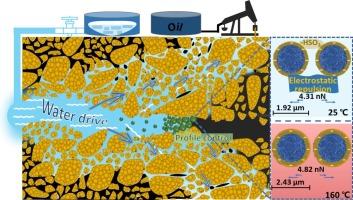具有“刚性疏水核-软亲水壳”结构的超高温耐盐微球,用于深层储层剖面控制
IF 13.2
1区 工程技术
Q1 ENGINEERING, CHEMICAL
引用次数: 0
摘要
超深层油藏的开发对调温剂的性能提出了更高的要求,由亲水性聚丙烯酰胺主链、杂环结构和刚性侧基组成的调温剂在温度超过120 ℃时性能不佳。本研究通过浓硫酸磺化合成了具有“刚性疏水核和软亲水壳”结构的磺化聚苯乙烯微球(SPS-2-3)。在高温下,SPS-2-3的亲水磺化层厚度增加,电荷量和电荷迁移率增强。这些变化使SPS-2-3表面电荷分布更加均匀,并扩大了静电相互作用的空间范围。因此,结合水的比例从4.37 %(室温)显著增加到26.93 %,SPS-2-3之间的静电斥力增加到4.82 nN,使SPS-2-3在温度超过160℃、盐度高达20 × 104 mg·L-1时具有优异的分散稳定性。原油动员特性表明,SPS-2-3有效提高了基质中剩余油的动员效率,注入压力提高3.5倍,采收率提高20.11 %。该研究为深部油藏开发中高性能调剖剂的设计提供了新的思路。本文章由计算机程序翻译,如有差异,请以英文原文为准。

Ultra-high temperature and salinity resistant microspheres featuring “Rigid hydrophobic core- soft hydrophilic Shell” structure for deep reservoir profile control
The development of ultra-deep oil reservoirs has posed greater demands on the performance of profile control agents, which composed by hydrophilic polyacrylamide main chain, heterocyclic ring structure and rigid side groups fail to perform decently in temperature beyond 120 °C. In this study, a sulfonated polystyrene microsphere (SPS-2–3) featuring a “rigid hydrophobic core and soft hydrophilic shell” architecture was synthesized through concentrated sulfuric acid sulfonation. At elevated temperatures, the hydrophilic sulfonated layer of SPS-2–3 exhibits increased thickness, alongside enhanced charge quantity and charge mobility. These changes facilitate a more uniform distribution of surface charges on SPS-2–3 and extend the spatial range of electrostatic interactions. Consequently, the fraction of bound water increases significantly from 4.37 % (room temperature) to 26.93 %, electrostatic repulsion between the SPS-2–3 is increased to 4.82 nN, endowing SPS-2–3 with superior dispersion stability under temperature surpassing 160°C and salinity up to 20 × 104 mg·L-1. The crude oil mobilization characteristics demonstrate that SPS-2–3 effectively enhances the mobilization efficiency of remaining oil in the matrix and achieves a 3.5-fold increase in injection pressure and 20.11 % increase in oil recovery. This study provides a new idea for designing high-performance profile control agents for applications in deep reservoir development.
求助全文
通过发布文献求助,成功后即可免费获取论文全文。
去求助
来源期刊

Chemical Engineering Journal
工程技术-工程:化工
CiteScore
21.70
自引率
9.30%
发文量
6781
审稿时长
2.4 months
期刊介绍:
The Chemical Engineering Journal is an international research journal that invites contributions of original and novel fundamental research. It aims to provide an international platform for presenting original fundamental research, interpretative reviews, and discussions on new developments in chemical engineering. The journal welcomes papers that describe novel theory and its practical application, as well as those that demonstrate the transfer of techniques from other disciplines. It also welcomes reports on carefully conducted experimental work that is soundly interpreted. The main focus of the journal is on original and rigorous research results that have broad significance. The Catalysis section within the Chemical Engineering Journal focuses specifically on Experimental and Theoretical studies in the fields of heterogeneous catalysis, molecular catalysis, and biocatalysis. These studies have industrial impact on various sectors such as chemicals, energy, materials, foods, healthcare, and environmental protection.
 求助内容:
求助内容: 应助结果提醒方式:
应助结果提醒方式:


